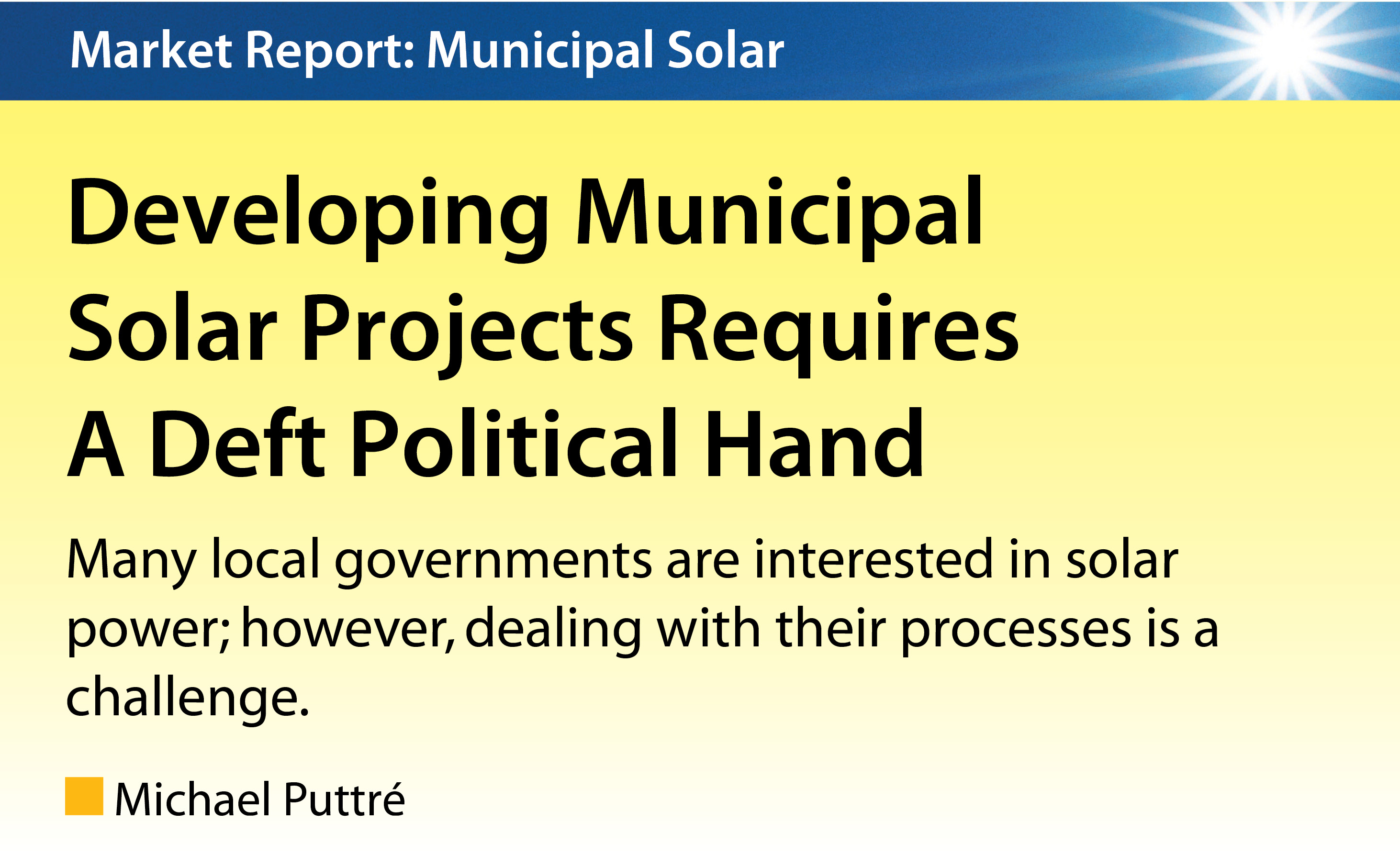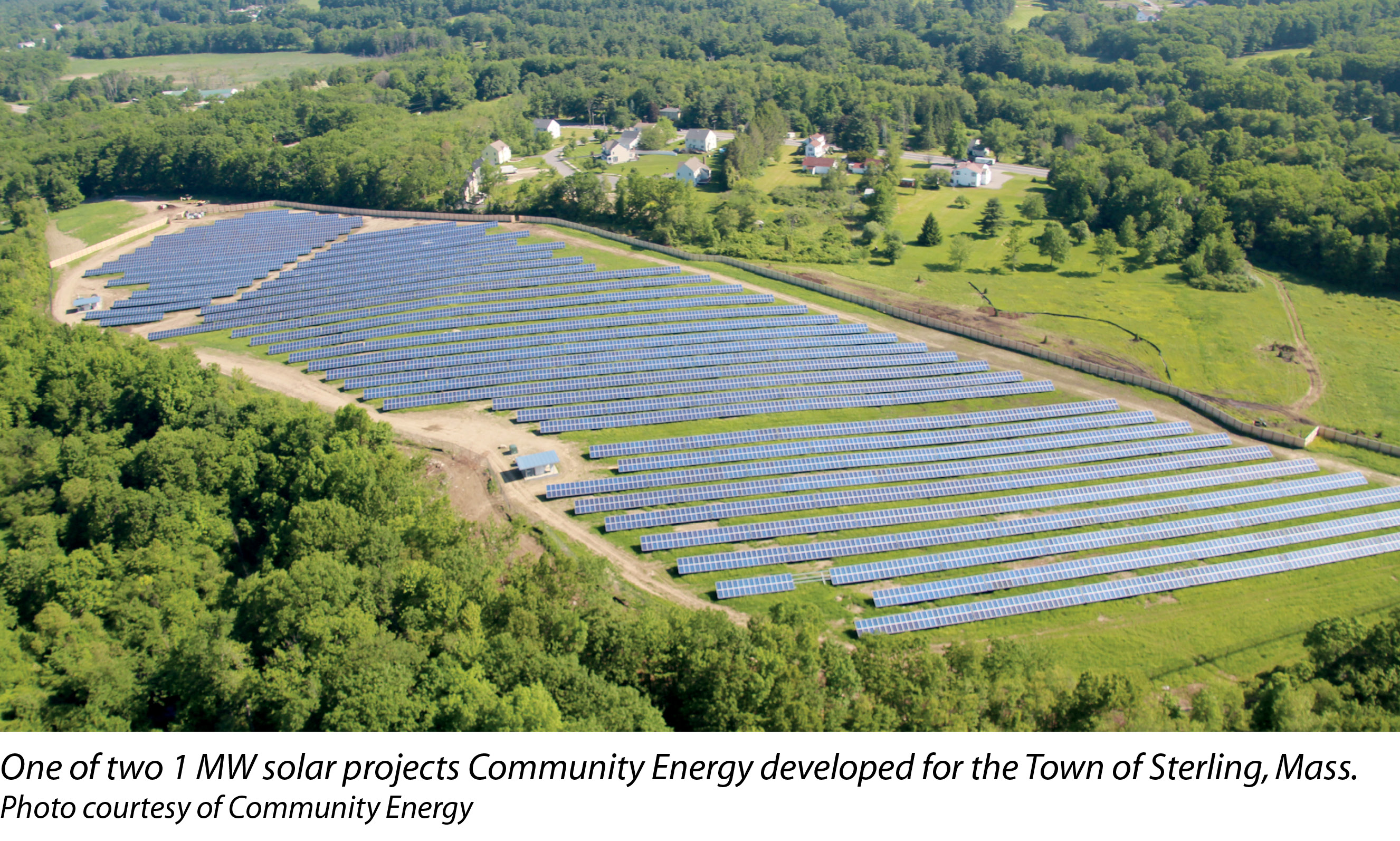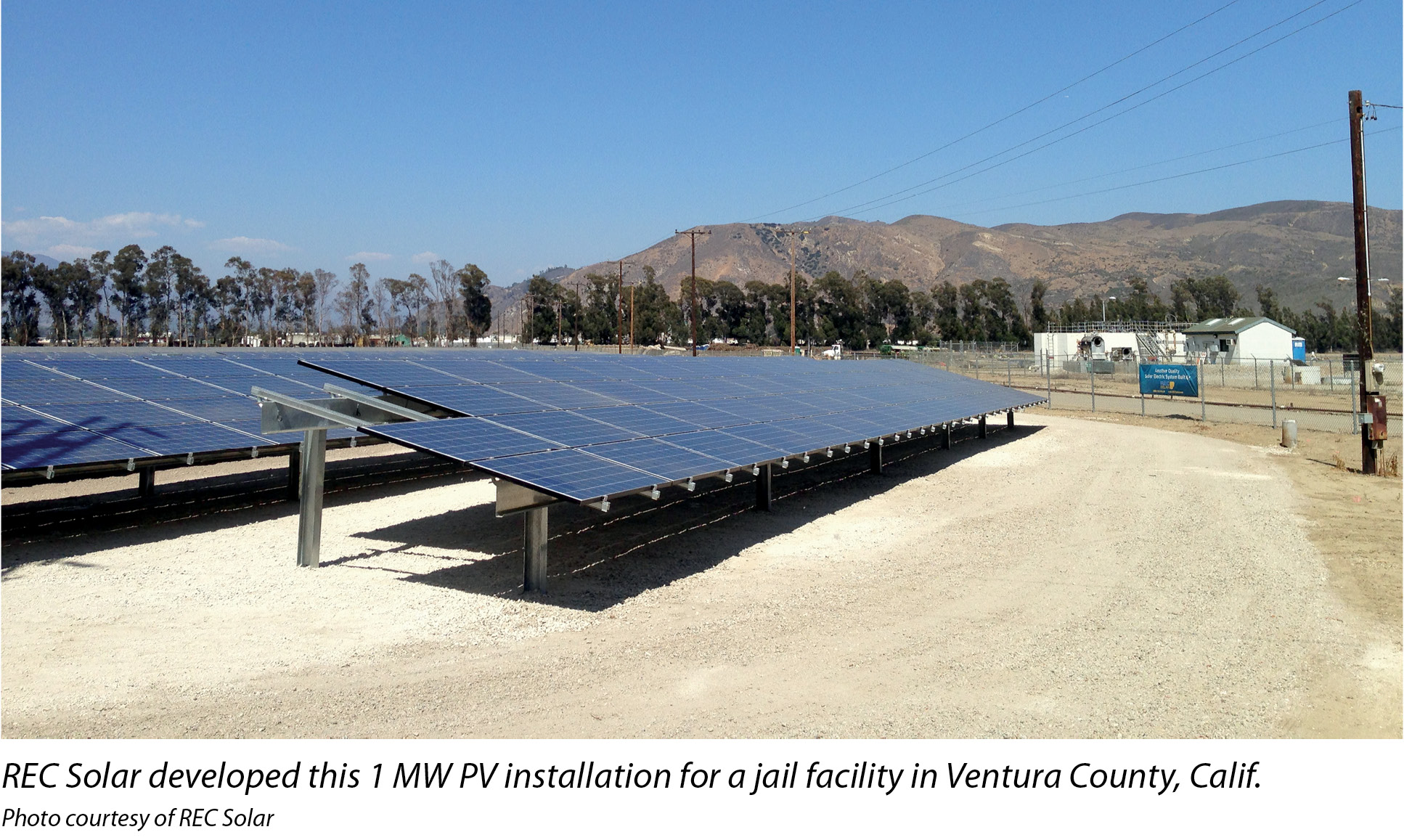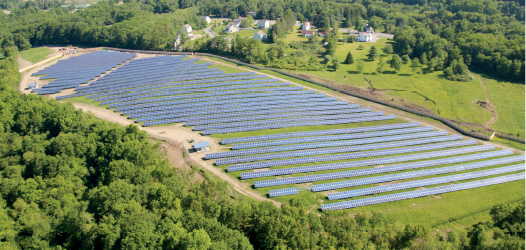

301 Moved Permanently
Solar projects for municipal customers are typically on a similar scale as those for commercial enterprises but come with their own sets of rules. Developers seeking to serve this active and growing market must master a rigorous and often long procedure-driven process. Moreover, this process is by definition under intense and even skeptical public scrutiny because such projects are financed by taxes and bonds.
Successful developers of solar projects for municipal customers report that preparing their own organizations for the effort is essential to play, let alone score winning bids and profitable outcomes. Such efforts include acquiring in-house expertise in public works that are specific to the style of county, city or town government involved. Securing local partners and project champions are also vital for successfully navigating the rules of the game.

“There are pros and cons to working with municipal customers,” says Joe Harrison, senior project developer in the Boston office of San Diego-based Borrego Solar Systems. “The private sector is able to move quicker when they make a decision. On the other hand, the private sector is not obligated to follow through. You are always one phone call away from having the customer go with someone else.”
Engage the political process
Borrego Solar pursues municipal solar customers because their requirements tend to fall within what the company describes as its “sweet spot” of 1 MW to 10 MW. Harrison notes that the customer base here consists of Fortune 1,000 companies, colleges and municipalities. “These are big users motivated to do the right thing for the community,” he says.
Of that group of large commercial-scale customers, the municipal solar market is also incredibly diverse.
“It is important to note that a municipal customer may be a stand-alone authority that supplies energy to a city of 100,000 plus half a dozen surrounding towns, or a small department in a town of 3,000 residents,” says Tom Tuffey, vice president of Radnor, Pa.-based Community Energy Solar LLC. “The former will have a full staff with departmental coordination and reporting structure, while the latter has one principal and a board to keep informed.”
Tuffey says large local governments, such as counties and cities, will likely use a full-blown request for proposals (RFP) process, while smaller entities, such as towns, may have an abbreviated process. In either case, he says, the customers are knowledgeable and committed, although specific knowledge of the ins and outs of solar projects might be outside their experience. Also, when a local government begins mulling over a possible solar project, everybody knows about it, and the customer soon has a lot to sort through.
“In some cases, we have had municipals with up to 40 solar developers that have approached them,” Tuffey says. “Municipal customers have all expressed the challenge of choosing the right partner in a technology new to them.”
According to Ryan Work, business development manager at REC Solar, to a large degree, solar power projects are not so dissimilar from other infrastructure improvements. Most of the work translates well. There are structural engineers, electrical engineers, and structures and connections have to follow codes. However, solar project definition does not necessarily come naturally to municipalities, although this is changing. Many municipalities are adopting solar bylaws as an overlay to land management and zoning.
“We can help with some of the project definition but don’t want to mess with the bidding process,” Work says.
In October, REC Solar completed the installation of a 1 MW solar energy system for the Ventura County Todd Road Jail facility in California. Work says this project proved to be an excellent case study for appreciating the nuances of developing solar for a municipal customer. The law in California required multiple bid responses from qualified firms, which were selected as part of a request for qualification (RFQ) process.
In the case of the $4 million Todd Road Jail project, the RFQ phase drew applications from about 30 firms. The top five qualified firms were then invited to respond to an RFP.
Work says REC Solar had the resources to put together a feasibility study of the proposed project on its own dime as part of its qualification submission. For its part, the county hired a third-party engineering consulting firm, AECOM, to develop its evaluation scorecard and produce a feasibility study of its own. The firm also managed the qualification process and helped evaluate and interpret qualification proposals.
“The customer had a good level of sophistication,” Work says. “The $4 million represented a large chunk of the Ventura County budget.”
The project was being financed through the county budget and bond process, Work says, so cost was an issue. The project had to be cashflow positive, or at least a cashflow-neutral vehicle. Adding to the cost pressure, municipal agencies are not able to monetize the benefits of a solar installation like a commercial customer can. The federal tax credit and depreciation are major financial incentives for a commercial customer that a municipal customer is not eligible for.
The cost issues and technical sophistication of the customer required a commensurate level of process sophistication from the bidding firms to get to the RFP round. Because the municipal market is a significant part of the company’s business strategy, REC Solar maintains in-house talent with experience working with local government.
“There is a process for every aspect of working with a municipal agency,” Work says. “Ultimately, there is a city council and subcommittees to meet with. There are more stakeholders involved. What’s more, it is a very transparent process. Everything is on the public record. You can track the entire project through its various stages.”
Hurry up and wait
Borrego Solar’s Harrison says he encountered many of the unique aspects of dealing with municipalities as customers in developing a 2.7 MW project for the City of Beverly, Mass. The array is on a private site, but the city is purchasing the net metering credits. Harrison says the approval process involved five city council meetings, three subcommittees and two public meetings.
“We had sort of thought we would receive approval at the first meeting,” he says.
Paul Mikos, executive vice president of sales and marketing at Huntington Beach, Calif.-based PsomasFMG, says in a commercial project, a CEO or general manager can make a quick business decision, usually motivated by the economics of the project. This is not the case with municipalities, even when the economics are clear.
“You would think that a financially strapped municipality would make a quicker decision, but they are very risk averse and need to have committees review everything,” Mikos says.
Understanding the specific dynamics of different forms of local government and then developing an appreciation of the personalities involved are perhaps the most challenging aspects of dealing with municipalities as customers. Is it an election year? What else does the government have on its plate? Harrison says local governments have a tendency to want to continue matters to the next meeting and give the residents a chance to have their say.
Harrison says the key to establishing a successful relationship with a municipality as a customer is appreciating that some of the frustrations are necessary and even laudable byproducts of representative government. That said, there are ways of managing this process.
“We have made a concerted effort to bring in experts in this area,” he says, adding Borrego Solar has two civil engineers on staff in Massachusetts who have long track records of projects in the commonwealth. “We always partner with a local civil engineering firm.”
Also invaluable is an advocate or champion within the government who takes the role of guiding the solar development project through the process.
“You always need a champion to push for your project,” Mikos says. “That champion can come from almost any department but must believe in the project and have the political pop to keep it moving up the chain.”
Solar in the public interest
Cost, not surprisingly, hovers over everything. Harrison says negotiating power purchase agreements with municipal customers, which generally retain outside counsel for the purpose, has been among the most intense he has ever been involved with.
Community Energy’s Tuffey says understanding the financial incentive structure of a given municipality is an important aspect for developing solar projects in the public sector.
“Some form of incentive is pretty much a must in most of the markets where we’ve had success,” Tuffey says. In Massachusetts and New Jersey, he says a strong solar renewable energy credits market has been key. In Indiana, it has been a feed-in tariff. In New York and Pennsylvania, it has been grants and performance incentives. In North Carolina, it has been an additional state investment tax credit and a solid off-take tariff. “All of these help the economics such that the municipality gets an attractive long-term price at a discount to their long-term energy price forecast.”
Despite all of the rigors of dealing with municipalities, solar developers with experience in this sector see tremendous opportunities for growth. S
Market Report: Municipal Solar
Developing Municipal Solar Projects Requires A Deft Political Hand
By Michael Puttré
Many local governments are interested in solar power; however, dealing with their processes is a challenge.


si body si body i si body bi si body b
si depbio
- si bullets
si sh
si subhead
pullquote
si first graph
si sh no rule
si last graph